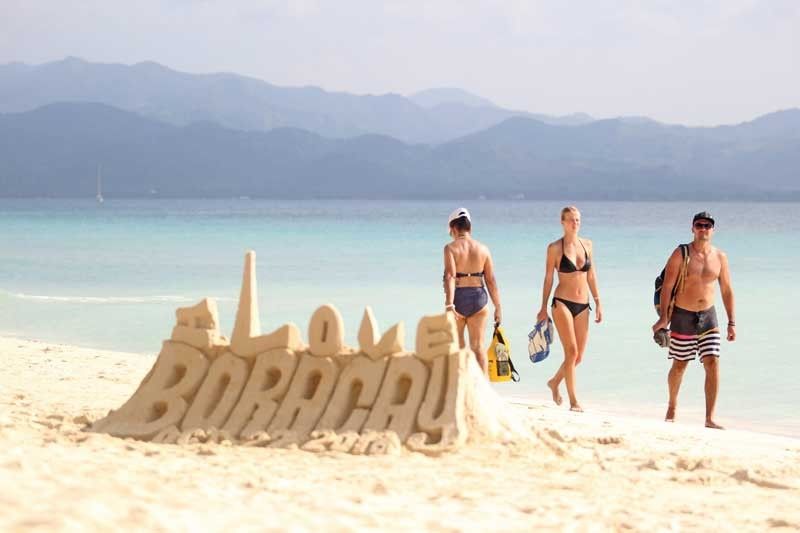Boracay draws 11,000 during 2-day break

MANILA, Philippines — As more than 11,000 people visited Boracay island during All Saints’ Day and All Souls’ Day, the Boracay Interagency Task Force (BIATF) fined 14 tourists caught violating regulations that have been set to protect and preserve the tourist destination.
“We issue citation tickets against violators. If they still don’t heed our warning, we may have to remove their accreditation,” Tourism Secretary Bernadette Romulo-Puyat told The STAR.
Puyat said seven were fined for smoking, three for littering and two for drinking on the beach.
The DOT chief added that one tourist was fined for making sandcastles while another one violated the prohibition on driving motor vehicles to the beach.
Puyat earlier said she was saddened by the action of tourists who defy the BIATF guidelines.
“It is very hard for me to believe na hindi nila alam ang mga (that they don’t know the) regulations,” Puyat said.
BIATF provides visitors copies of the “Oath for a Better Boracay” before they enter the island as they are expected to observe environmental laws and regulations.
Puyat said she is hopeful that tourists will do their part in preserving the environment.
She added that she sees the Philippines becoming a good example as far as sustainable tourism development is concerned.
“Everybody is saying they are amazed by the Philippines. In fact, other countries are visiting us. We are really a model for sustainable tourism... (Boracay’s rehabilitation) is just the beginning. We want all major tourism destinations to practice sustainable tourism,” Puyat was quoted as saying in a CNN International report.
The Municipal Tourism Office at the Caticlan Jetty Port said 5,418 tourists visited Boracay on Nov. 1 and 5,813 on Nov. 2.
In line with preserving the island, BIATF is enforcing a limitation on the number of tourists allowed in the island, currently pegged at 19,215 guests per day.
The Department of Environment and Natural Resources earlier commissioned a study on the carrying capacity of Boracay, which found that the island and its swimming areas could only support 55,757 people per day – 36,542 residents and workers and 19,215 tourists, with 6,405 visitors allowed to enter the island per day.
Meanwhile, the DOT said it would continue to accredit compliant accommodation establishments that pass the standards of the agency.
“More rooms will be available as we continue on with Phases 2 and 3 of Boracay’s massive rehabilitation. We are making sure the Task Force requirements are 100 percent complied with,” Puyat said.
The Department of the Interior and Local Government said it is also studying the possibility of closing the island for one month every year, specifically during the southwest monsoon season, to allow the island to heal itself.
Business and investment
The reopening of a better Boracay is seen to drive potential opportunities for business and investors, property consultancy firm Prime Philippines said.
“For the businesses and investors, this reopening serves as yet another opportunity to take advantage of this teeming haven full of visitors in search for accommodations and other necessities,” Prime Philippines said.
At present, there are 157 Boracay accommodation establishments allowed to operate, as they have complied with the requirements of BIATF.
This translates to a total of 7,308 rooms.
“Skeptics may go against this positive direction for the island but agencies and investors are working hand in hand to maintain a sustainable environment and a controlled growth at the same time,” it added.
Prime Philippines emphasized that the long overdue rehabilitation of Boracay calls for cooperation across the island in order to tap its promising potential driven by sustainability.
“Start anew and start strong,” it said.
People’s welfare
But Advocates of Science and Technology for the People (AGHAM) insisted that the six-month rehabilitation of Boracay only hid its further commercialization and privatization.
“(Data) from local people’s organizations such as We Are Boracay, Rise Up Aklan and Friends of Boracay revealed that such plans were poorly executed and that it has only aggravated their already difficult living situation,” said Krista Melgarejo, deputy secretary-general of AGHAM Diliman. “It is clear that from the start, the Duterte administration’s rehabilitation of Boracay was poorly thought out. Aside from the absence of a transparent, scientifically sound and comprehensive rehabilitation plan to address the environmental degradation, the rehabilitation clearly is not centered on the welfare of the Filipino people affected by the closure,” Melgarejo insisted.
“If we really want to save what’s left of our natural resources, the government should not put private interests above people’s interests. It should involve local scientists and experts and the local residents in coming up with and implementing effective solutions,” she said. – With Catherine Talavera, Rhodina Villanueva
Related video:
- Latest
- Trending






























